
It’s that time of year again—time to buy more board games than you possibly have time to play.
To aid you in your quest, we’ve once again updated our massive board game buyer’s guide for the year by adding new entries, pruning some old ones, and bringing things in line with our current thoughts. This isn’t necessarily a list of our favorite games of all time; it’s just a big list of games we’re recommending in 2019. The list is divided into sections that cater to different audiences, and we think there’s something here for just about everyone.
Whether you’re looking to pick up your next cardboard obsession or need a gift idea for your weird cousin who’s always going on about “efficient resource trade routes,” you’re in the right place.
Table of Contents
- Family and new gamers
- Next steps
- Midweight strategy
- Thematic games
- Heavier fare
- Card games
- Party
- Modern classics
- Two-player games
- Escape room games
- Stocking stuffers
For fun, here's a giant gallery of the box art for every game in this guide:
-
-
-
-
-
-
-
-
-
-
-
-
-
More Istanbul!
-
-
-
-
-
-
-
-
-
-
-
-
-
-
-
-
-
-
-
-
-
-
-
-
-
-
-
-
-
-
-
-
-
-
-
-
-
-
-
-
-
-
-
-
-
-
Note: Ars Technica may earn compensation for sales from links on this post through affiliate programs.
Family and new gamers
If you're new to gaming (or simply trying to hook the unconverted), this is your section. Each game below is great for playing with people who are just dipping their toes into the big board game ocean. Colorful pieces, simple rules, and addictive gameplay—they don't call them "gateway games" for nothing.
Splendor
2-4 players, 30 minutes, age 10+, $36 on Amazon
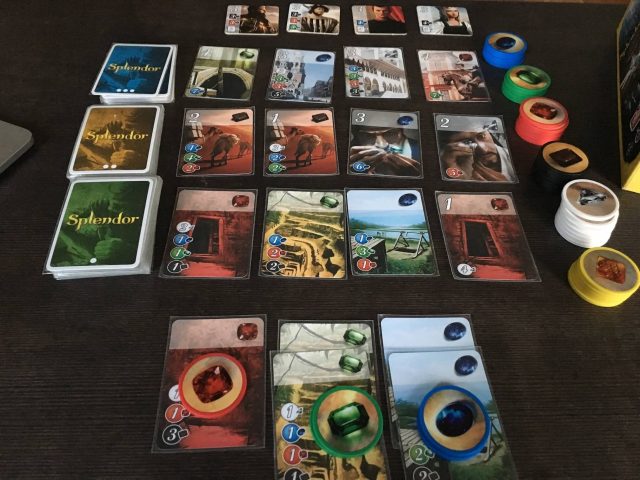
Azul
2-4 players, 30-45 minutes, age 8+, $19 on Amazon
-
Nate Anderson
-
Azul in play—a two-player game in progress.
Based on Islamic-inspired Portuguese tiles called azulejos, this family-weight abstract involves collecting sets of similar tiles and slotting them into rows on your personal game board. When a row is completely filled, one of its tiles is moved over into the square pattern to the right, garnering bonuses depending on placement. Turns are quick, and each set of tiles you grab creates both problems and opportunities for other players. There's a tinge of "meanness" for players who are sensitive to that sort of thing, but it's essential to Azul's wonderful interactive tension.
Gorgeous bakelite-style tiles seal the deal on a beautiful production. Read our review here.
Reef
2-4 players, 30-45 minutes, age 8+, $34 on Amazon
-
A reef in construction.Aaron Zimmerman
-
When you play a card, you get the colored pieces on top and place them anywhere on your board. You then get points if you've managed to match the pattern on the bottom of the card.Aaron Zimmerman
Reef comes to us from the same company that brought us Azul and the designer who brought us Century: Spice Road. Read our review here.
Kingdomino
2-4 players, 15-20 minutes, age 8+, $20 on Amazon
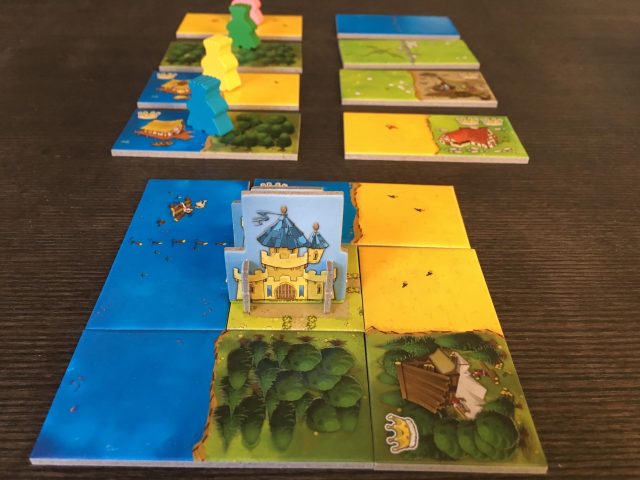
Kingdom Builder
2-4 players, 45 minutes, age 8+, $30 on Amazon
How's this for "accessible gameplay"? Kingdom Builder, which won Germany's prestigious Spiel des Jahres award in 2012, can be taught in less than five minutes and gives each player just one card per turn—but it also offers a modular board, different scoring cards for each game, and unique bonus powers. While the rules here are easy enough to grasp, Kingdom Builder goes well beyond our gateway suggestions in the strategic thinking it requires. Placing three of your settlements each turn onto a large and lovely map sounds simple enough in practice, but making proper use of the required terrain cards, snagging the most useful bonus powers for your strategy, and puzzling out ways to earn maximum points based on each game's scoring conditions is far more difficult than it looks—especially with three or four players cluttering up the board. Multiple (good) expansions are available, including one that adds a fifth player color, but the base game should keep you occupied for quite some time.
Next steps
If your want slightly more complexity than games in the previous section, here are some "next step" games that kick things up a bit but still remain accessible for new gamers. This is a super-popular category, so we've expanded it to include extra entries this year.
Wingspan
1-5 players, 40-70 minutes, age 10+ (Prices on Amazon are currently over retail, check your local shop)
-
LOOK AT ALL THIS FUN STUFF.Aaron Zimmerman
-
In Wingspan, players are bird enthusiasts trying to attract birds to their aviaries. There are 170 unique bird cards in the game.Aaron Zimmerman
-
A game in action.
-
The birdhouse dice tower is adorable.Aaron Zimmerman
-
When you pick a die from the birdfeeder, you take a corresponding food token.Aaron Zimmerman
-
These are not chocolate eggs, no matter how much you may want them to be.Aaron Zimmerman
-
The game comes with these handy plastic trays for storage both in and out of play.Aaron Zimmerman
-
Cards are stored in this included box, which reminds me of a baby wipes container.Aaron Zimmerman
-
Its lid serves as a card display during play.Aaron Zimmerman
-
Player colors are often boring. Not here!Aaron Zimmerman
-
Objective cards give you end-game goals to shoot for.Aaron Zimmerman
-
(They even show the percentage of applicable cards in the deck. More games need to do this.)Aaron Zimmerman
-
Variable end-of-round bonuses keep you on your toes throughout the game.Aaron Zimmerman
-
Here's all you need to play a quick solo game.Aaron Zimmerman
Birds are represented by cards, and you slot those cards into rows on your personal player board to score points and gain special powers. Each row is keyed to a certain action—scavenging for food, laying eggs, etc—and when you perform that action, you also activate all the special powers of the birds in that row. Start with nothing, and by the end of the game, you’re drowning in worms and eggs (this is… a good thing).
Wingspan is a perfect “next step” game that’s quick to teach and a joy to play no matter your gaming experience level. Read our review here.
Parks
1-5 players, 40-60 minutes, age 9+ (Prices on Amazon are currently over retail, check your local shop)
-
Parks: for my money, the best-looking game at Gen Con 2019.
-
Players travel along the bottom path to collect resources and special abilities.
-
Cute little hikers.
-
Gorgeous artwork from the 59 Parks Print Series.
-
More!
But a game is nothing without compelling gameplay, and Parks thankfully brings along plenty of fun decisions for newer gamers and old hands alike. The game tasks players with making their way down a hiking trail using two hikers, with each space granting you resources or special actions. Any hiker on a space blocks other hikers from landing on it, so the trick is finding the best spots to exploit and the best time to hop on down the trail.
At the end of the trail, you can trade your resources (sunlight, water, mountains, trees, etc.) to visit a national park. Does this make sense? Not really. Is it fun? Yes. You’ll also be taking pictures of your travels, buying equipment to help you along your way, and filling up your trusty canteen whenever the opportunity presents itself. Pick up this delightful little game for the outdoors enthusiast in your life.
Quacks of Quedlinburg
2-4 player, 45 minutes, age 10+, $34 for UK edition, $55 for US at Amazon

A ridiculously fun press-your-luck bag-building game about being a charlatan at a medieval fair, hawking crazy potions that you mix up out of dubious components plucked unseen from your stash. Each one makes the potion stronger, but beware the white berries—too many and your cauldron will bubble over. The game has wonderful, whimsical art, terrific replayability, and great components—including rubies and rat tails. And because everyone builds their potions simultaneously, this is another game with almost no downtime between turns.
Quacks won the prestigious Kennerspiel des Jahres game award in 2018, and with good reason. You're not technically required to love it, but if you're a gamer (or in love with one), you should at least try it.
Gizmos
2-4 players, 50 minutes, age 8+, $50 at Amazon
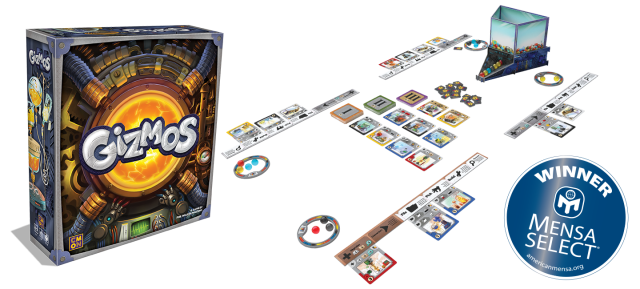
Dice Forge
2-4 players, 45 minutes, age 8+, $36 at Amazon
Pure engine-building fun with chunky plastic dice. On each turn, you roll your dice, store up resources, and then purchase cards that give you special abilities or—and here's the game's "gimmick"—buy even better die faces. That's right: much of the game consists in buying more powerful resources from a large tray of faces, then replacing an existing face on one of your dice. By game's end—about 45 minutes—you're rolling killer combos every time.
The game is one of the most gorgeous presentations I have ever seen in board gaming, the die faces come off with a satisfying "pop," and there are more available card powers than you can use in a single game. Terrific family entertainment.
Machi Koro Legacy
2-4 players, 1 hour, age 10+, $33 at Amazon
-
Pandasaurus Games
-
Pandasaurus Games
I didn't like the original Machi Koro. It had too many "take that" cards and several fixed strategies that felt constraining. I sold my copy and moved on.
BUT THEN. Machi Koro Legacy came out, and it promised to fix the game's issues. Players still roll dice, activate buildings that have the dice number on them, and buy new buildings to crank up their engine. But the initial set of cards contains no "take that," and each playthrough of the game adds new cards, fun little plastic bits from secret boxes, rule tweaks, and different objectives. Everything feels more dynamic.
As with most "legacy" games, you end up writing on player mats, placing stickers, and making other irrevocable changes that customize your copy as you play. But unlike some other legacy games, Machi Koro knows that it's a lighter offering. It offers 10 defined campaign plays, rather than the 15-20 plays similar games sometimes require, after which you can continue to play the game without further changes. Rule tweaks and innovative mechanisms are fun but modest, so you don't find yourself scared to play after setting it aside for a couple of weeks. It's pure fun, and I've had a blast playing through the campaign with two of my kids—even if I've only won a single game.
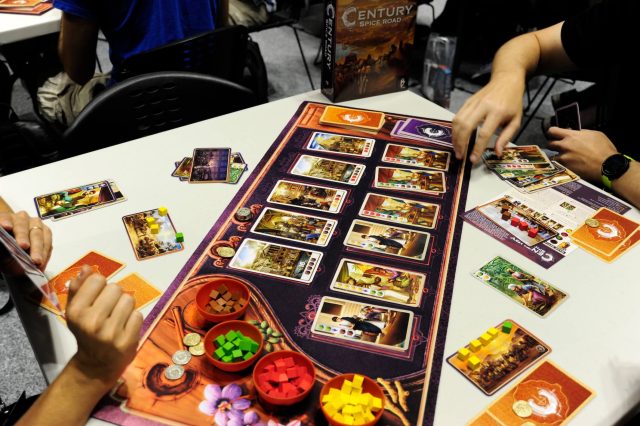
Istanbul: The Dice Game
2-4 players, 20-30 minutes, age 8+, $22 on Amazon
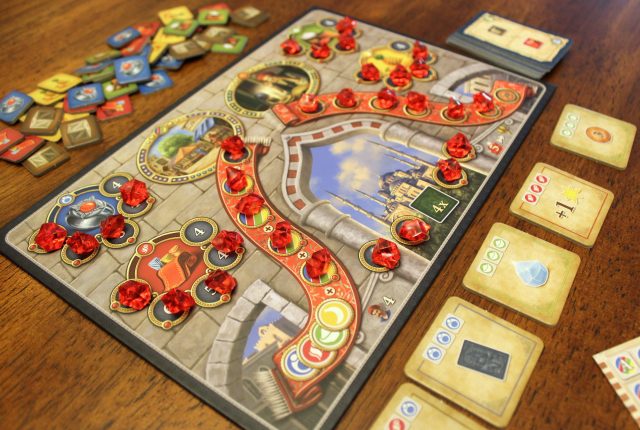
That's when you reach for Istanbul: The Dice Game. With quick setup, lightning-fast play, and some basic engine-building, this is a race for rubies in the vein of its big brother, Istanbul, but without the movement. Roll some dice and get some stuff, which you can use to buy tiles that get you even more stuff. Acquire extra dice, bonus actions, or re-roll crystals—or just stash goods to use on future turns. But don't wait too long to purchase rubies; with every one bought, the price of the next one increases. Read our full review here.
Sagrada
1-4 players, 20-40 minutes, age 14+, $30 on Amazon
Constructing real stained-glass windows may or may not sound like a good time, but it's pure pleasure in the world of Sagrada. In this dice-drafting game, players take turns picking dice from a pool available each round, then slotting those dice into the "window" they're constructing on a personal player board. The boards themselves dictate where certain dice can go—only red dice here, only 2s here—while the game itself has its own global placement rules. The trick is combining these placement restrictions with the dice on offer in any given round to maximize points based on the four different scoring cards that shape each game (three of these cards are public, one is private to each player). Because this can be difficult, the game also offers "tools" that can alter some of the rules—for a fee. Sagrada plays quickly, looks gorgeous on the table, and is a satisfyingly thinky experience with low rules overhead. Highly recommended for gamers who like solving puzzles.
Lords of Waterdeep
2-5 players, 60-120 minutes, age 12+, $38 on Amazon
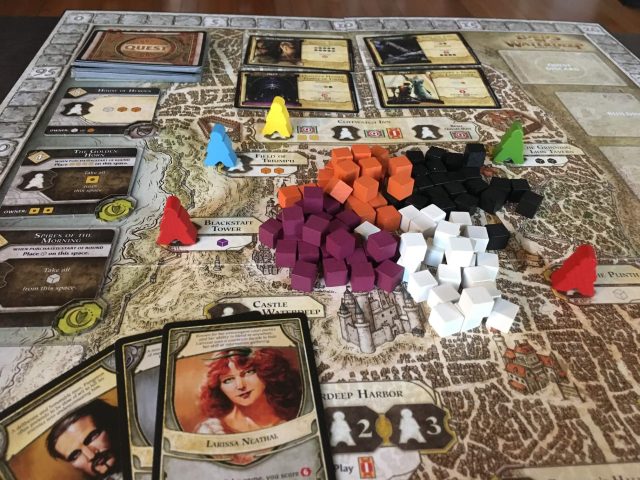
Midweight strategy
For many people, midweight strategy games are the sweet spot between brain-burning, all-day affairs and lighter, "filler"-type games. These games generally play in an hour or two and provide a ton of interesting decisions for people with a little experience under their belts.
Kemet
2-5 players, 90-120 minutes, age 13+
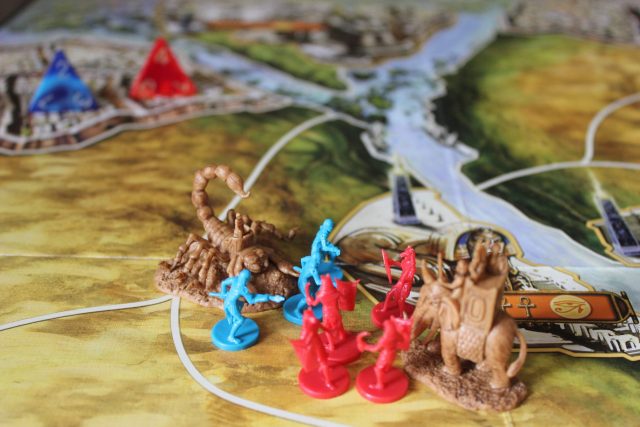
The game takes place in a mythological ancient Egypt, where warring factions ride massive creatures into battle to vie for control over powerful temples. The game is a race for points, with variable end points depending on how long you want to play. You’ll be purchasing new abilities from a huge central market (which also includes the cool monsters you can wreak havoc with) and maneuvering around the battlefield picking fights with your friends. Combat is handled through cards, and it’s based on strategic mindgames as opposed to lucky dice rolls.
The game supports up to five players, and it’s at its best at higher player counts. If you can’t get enough of the base game, a few expansions are available. If you’ve ever wanted to scream into battle on the back of a giant scorpion, Kemet is your game.
Viticulture: Essential Edition
1-6 players, 45-90 minutes, age 13+, $45 on Amazon
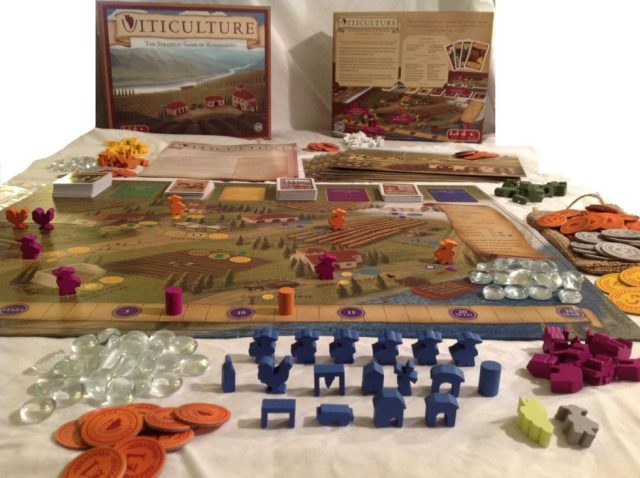
Lorenzo il Magnifico
2-4 players, 60-120 minutes, age 12+, $48 on Amazon
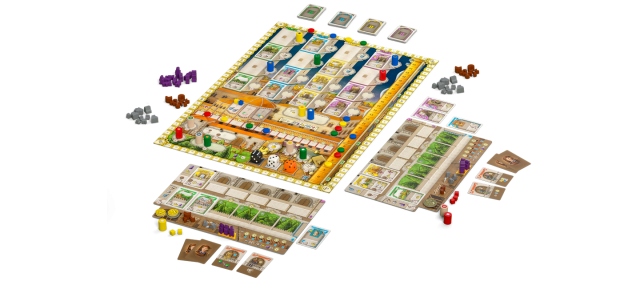
But the game puts some interesting twists on well-worn gameplay tropes, most notably in its worker placement. At the beginning of each round, three colored dice are rolled, which are keyed to specific workers in each player's employ. The number on each die determines its corresponding workers' power for the round—if you roll a 5 on the orange die, every player's orange worker has a power of 5. The higher the number, the better stuff you can get from the main board, including resources and, most importantly, cards. The cards drive your strategy; you can construct a resource-production chain, go heavy into the military, or recruit helpers that give you special powers.
One of our favorite Euros from the past several years, and we love Euros.
Coimbra
2-4 players, 60-90 minutes, age 14+, $45 on Amazon
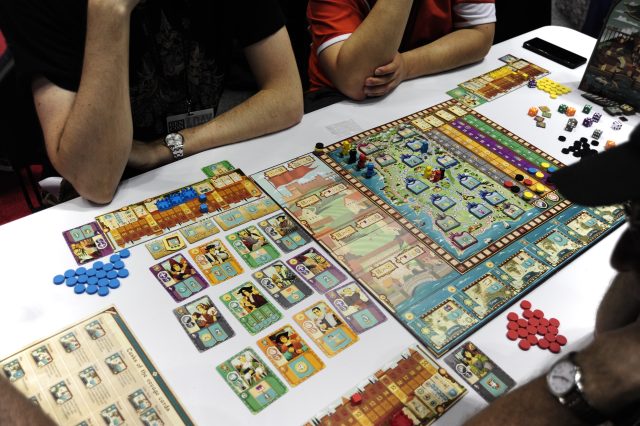
The Castles of Burgundy
2-4 players, 30-90 minutes, age 12+, $30 on Amazon
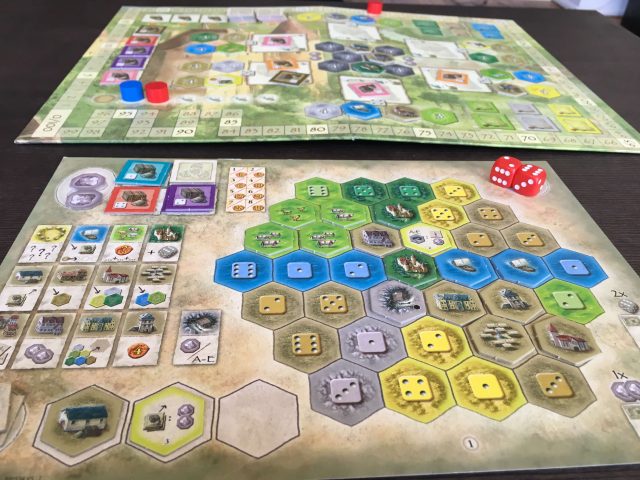
Roll for the Galaxy
2-5 players, 45 minutes, age 13+, $41 on Amazon

Concordia
2-5 players, 100 minutes, age 13+, $48 on Amazon
Concordia exemplifies a common board gaming buzzword: elegance. The rules are simple for a midweight Eurogame, but the explosion of strategic options those rules open up is dizzying. Part deckbuilding, part resource management, part economic route-building, Concordia tasks players with expanding a Roman dynasty across the Mediterranean, building cities, establishing trade routes, and, of course, jockeying for position against other players. All of the game's mechanics notch together in a wonderfully complex clockwork, forcing you to consider how every action you take affects the many competing and intertwined goals that make up your overall strategy. We could not recommend this game more highly.
Thematic games
From dice-chucking "Ameritrash" to text-based crime solving and cooperative legacy-building, these are our picks for those who want to be completely immersed in their tabletop experience.
Gloomhaven
1-4 players, 60-120 minutes, age 12+, $110 on Amazon
-
-
A player's area during play. Gloomhaven takes up some space.
-
The included insert holds the game's card, miniatures, and class boxes well.
Gloomhaven's $140 price tag doesn't put it in impulse-buy territory, of course, but if anything, the game is underpriced due to the ridiculous amount of content on offer. If you have a group with the wherewithal for Gloomhaven's "legacy"-style campaign play (and the patience for its admittedly arduous setup), this is a board game experience of a lifetime. Read our review here.
Imperial Assault
2-5 players, 60-120 minutes, age 14+, $68 on Amazon
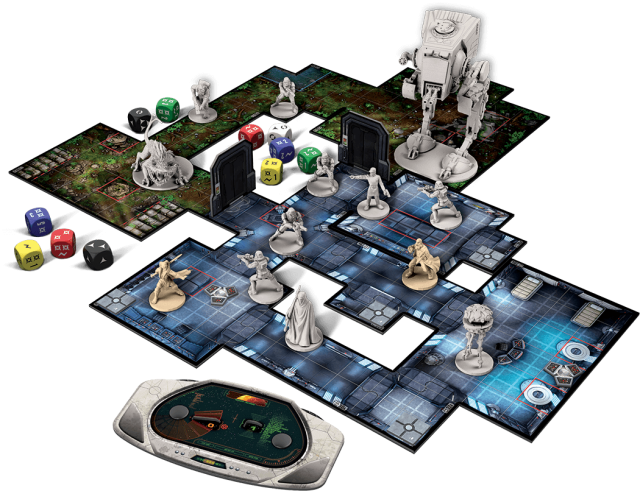
Various cleverly linked narrative campaigns offer months of entertainment for a dedicated group, while the skirmish mode allows two players to select small armies and battle one another on an equal footing—two very different games in one admittedly expensive box. Of course, this being a FFG game, there are expansions. Forty-eight, in fact, at last count, including five big boxes, dozens of miniature packs, and seven skirmish maps. More are on the way because Fantasy Flight can't seem to help itself—and Star Wars is the IP that laid the golden egg. Read our review here.
Mansions of Madness: Second Edition
1-5 players, 120-180 minutes, age 14+, $87 on Amazon
With last year's second edition, the job of Keeper was outsourced—to your tablet. An app now controls the narrative so that players can unite for a totally cooperative experience. Mansions of Madness: Second Edition has all the hallmarks of a big-box Fantasy Flight game—huge theme, lots of dice rolling, and high-quality components. If your giftee likes thrill-ride, funhouse horror board games, this game needs to be on their shelf. You can read our review here.
Sherlock Holmes Consulting Detective: Jack the Ripper & West End Adventures
1-8 players, 1-3 hours, age 10+, $45 on Amazon
Nothing puts you into Holmes' shoes—or his distinctive deerstalker—like Sherlock Holmes Consulting Detective (SHCD), a deduction adventure that has been around for decades but has finally gotten a lavish new edition and some revised cases. SHCD isn't a traditional "game;" it's a cooperative affair that involves your team trekking across Victorian London, reading interviews, and perusing newspaper articles for clues. The more locations you visit, the worse your score. Can you beat the master, Holmes himself, to the solution? Well... no, you can't, but that's hardly the point. These are terrific (and surprisingly well-written) multiplayer adventures. Buy the second set of cases and you'll be treated to a linked series of Jack the Ripper mysteries that culminate in a chance to stop Jack himself.
Pandemic Legacy (Seasons 1 and 2)
1-4 players, 60 minutes, age 13+, S1 $57 on Amazon, S2 $54 on Amazon
Heavier fare
Longer and more complex, the games in this section are "gamer's games." Here are a few recommendations to keep those brains churning.
Terra Mystica
2-5 players, 60-150 minutes, age 12+, $60 on Amazon
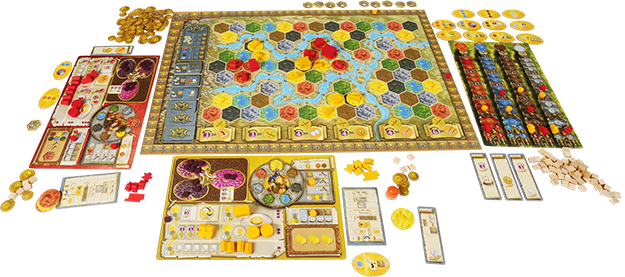
The more players you have, the more interesting the game becomes, and we'd recommend at least three players for the full experience. All information is open, and there's almost no luck involved, meaning that skill alone will lead you to victory. This also means that vets have a distinct advantage over newbies. But Terra Mystica is a game about building a kingdom, and that's fun even if you don't come in first.
Terra Mystica is an undisputed modern classic for a reason—it's deep, complex, interactive, and very, very fun.
Spirit Island
1-4 players, 90-120 minutes, age 13+, $54 on Amazon
Scythe
1-5 players, 115 minutes, age 14+, $65 on Amazon
Scythe is a huge, lavish production with top-of-the-line components and fantastic gameplay. Playing a game of Scythe feels like An Event, even though it won't take you the entire day to get through. Highly recommended. You can read our review here.
Feast for Odin
1-4 players, 30-120 minutes, age 12+, $79 on Amazon
In many ways, A Feast for Odin is a mashup of key design ideas from Uwe Rosenberg's impressive oeuvre—there's the sandboxy worker placement of Caverna and Fields of Arle, the occupational strategy-coaxing of Agricola, and, of course, the Tetris-style spatial puzzling of Patchwork and Cottage Garden. That it all fits together into a cohesive, deep, and fun experience is a testament to Rosenberg's near-unmatched design chops.
Board games have reached "peak Viking" territory, but the theme works well here. You'll be hunting, gathering, pillaging, and exploring in order to fill your player board with the spoils of a Viking life well-lived. The huge, player-driven openness of the game can be overwhelming, but that vastness gives the game an incredible depth and the potential for some big-time replayability. In short, it's complex bliss.
Terraforming Mars
1-5 players, 120 minutes, age 12+, $45 on Amazon
Terraforming Mars has piles and piles of colored and metallic cubes that really make the experience on a primal level, but the artwork is unfortunately a bit bland and unpolished. That does really matter when you're having so much, though. It's a game of card drafting, as players take on the role of corporations paid to turn the Red Planet green. You start with lichen and balance six resources in the hope of ending up with cities and oceans. If there's one criticism, it's that there's not much player conflict, but Terraforming is a deep and deeply replayable puzzle. Read our review here.
Card games
Don't want to break out a board and a million little cardboard pieces? From drafting to trick-taking to everything in between, these card games are great for beginners and vets alike.
Marvel Champions: The Card Game
1-4 players, 45-90 minutes, age 14+
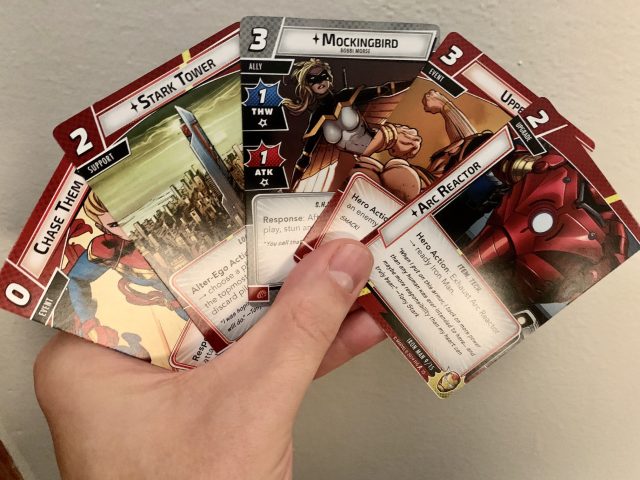
Marvel Champions is essentially a streamlined (and somewhat pared-down) version of Fantasy Flight’s very popular Lord of the Rings Card Game system, with some fun superhero-specific mechanics thrown in to keep things optimally thematic. You play the game cooperatively with up to three friends—we recommend solo or 2-player games to keep things moving—and fight against the game itself. Choose a scenario, choose a hero deck, and you’re off.
Victory requires spending time in both your hero and alter-ego forms, thwarting the villains’ nefarious schemes (“thwart” is an actual hero stat) and just beating the living snot out of the villain himself. The heroes in the core set are Spider-Man, Iron Man, Black Panther, She-Hulk, and Captain Marvel; the villains are Rhino, Claw, and Ultron. Marvel Champions is a Living Card Game, which means new (non-randomized) expansions will be released on a regular schedule. And for the first time ever, you can fully engage in the game’s (simple) deckbuilding with only one core set. Progress, FFG!
Point Salad
2-6 players, 15 minutes, age 10+, Amazon link
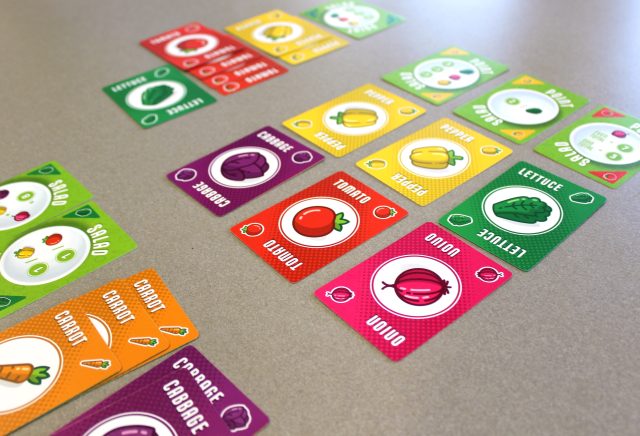
Arboretum
2-4 players, 30 minutes, age 8+, $17 on Amazon
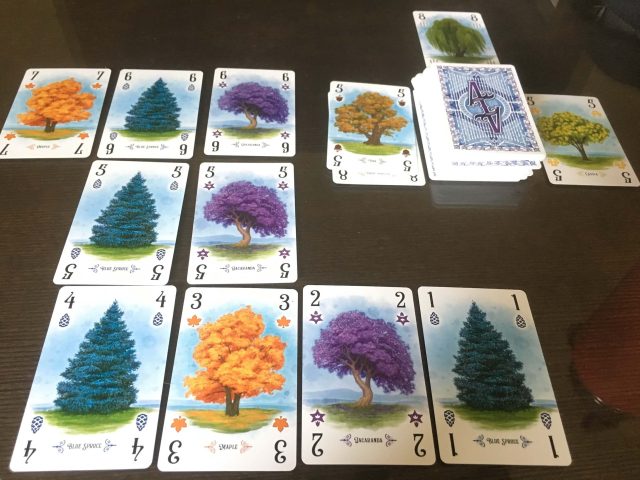
Arboretum was originally released in 2015, but it was so hard to get hold of that Renegade Games' new version might as well be the game's true release. If you're into tense card games with plenty of difficult decisions, you'll love Arboretum.
Port Royal
2-5 players, 20-50 minutes, age 8+, $17 on Amazon
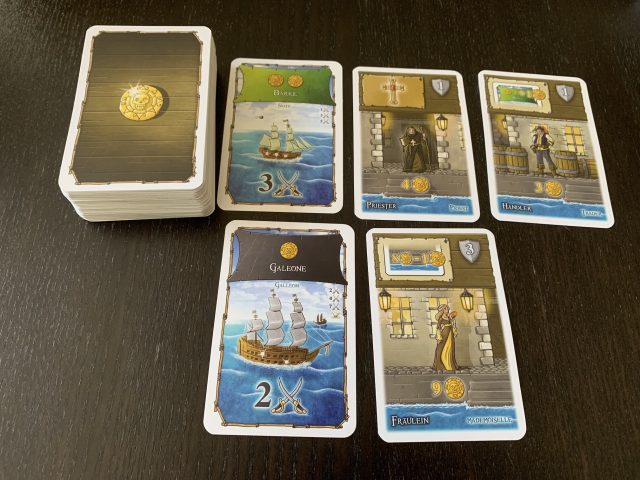
We've been recommending Port Royal to friends for years, but until last year, Americans had to import a copy from Europe if they wanted to join in on the fun. Thanks to Steve Jackson Games, the game is now available in your local game shop. The main difference with the new version (besides the box art) is that the ship flags have gone from easily readable colors to more complicated nation flags—a downgrade, to be sure. Still, Port Royal is a blast that scratches both engine-building and gambling itches, and it's great as a filler.
Sushi Go Party!
2-8 players, 20 minutes, age 8+, $20 on Amazon
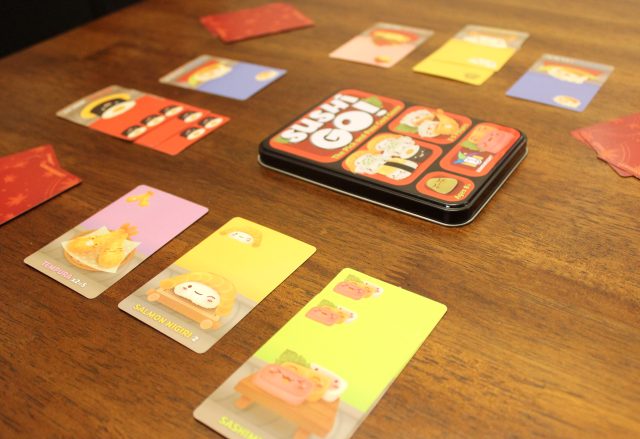
Fabled Fruit
2-5 players, 20-30 minutes, age 8+, $45 on Amazon
Collect sets of fruits and turn them into juices. It might not sound interesting, but designer Friedemann Friese has turned a gigantic stack of cards into a game that never plays the same way twice. Cards on the table act as worker placement spaces, each offering some unique, fruit-related action. As players collect relevant sets of juices, they can cash them in for one of the cards on the table, flipping it over to the "juice" side. A new card then comes off the ordered draw stack, often adding a completely new action space to the game. (Each action appears on four cards.) When an existing set of cards is turned completely into juices, its action disappears from the table completely. The result: a simple game that keeps morphing into something new, leading groups of players through new mechanisms, twisting rules, and additional pieces drawn from the box. Not quite a "legacy" game, as it can be reset to its initial state at any time, Fabled Fruit is a terrifically twisty experience worth working through in a group. (If you like the game, the "Lime" expansion came out in December 2017.)
Party
Got more players than the standard two to four? Party games have you covered. Lie to your friends, flex your word-association powers, even pilot a submarine—the games on this list are guaranteed to inject a raucous good time into your gathering. Non-gamer friendly, too!
Resistance: Avalon
5-10 players, 30 minutes, age 13+, $17 on Amazon
At the beginning of Avalon, you are given a card that tells you whether you're a good guy or a bad guy. Players then embark on a series of quests; the good guys want to succeed, while the bad guys want to secretly tank the mission. Rooting out the betrayers (or hiding from the noble do-gooders) requires more than a little cunning, treachery, and a willingness to make wild, baseless accusations. (Check out our favorite bluffing game list here.)
Codenames
Codenames: 2-8 players, 20 minutes, age 10+, $15 on Amazon
Codenames Duet: 2 players, 20 minutes, age 10+, $11 on Amazon
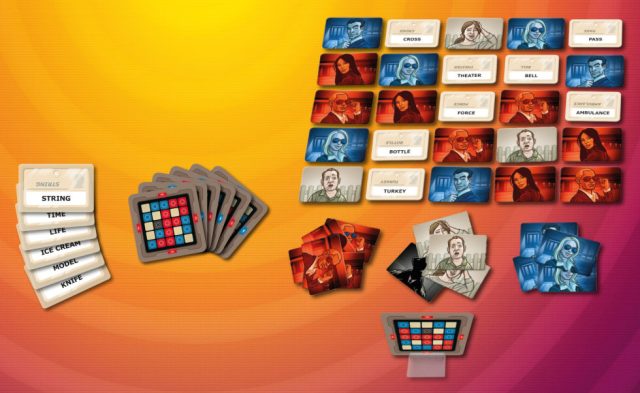
Dixit
3-6 players, 30 minutes, age 8+, $21 on Amazon
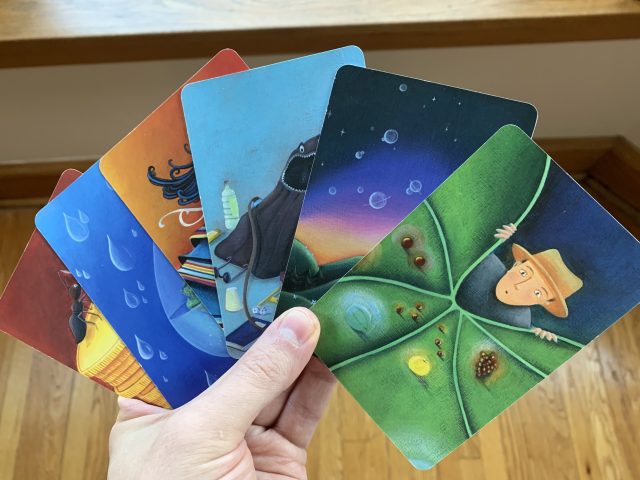
The game works because there are many different elements on each card, and they're all expressive and open to interpretation. We like to take things a step further by allowing clues to be anything—noises, a dance, whatever gets your point across. Dixit works wonderfully in some groups and not at all in others, and you probably know if it's right for you group from the description. For a more "gamey" version of the same concept, check out Mysterium.
Coup
2-6 players, 15 minutes, age 10+, $13 on Amazon
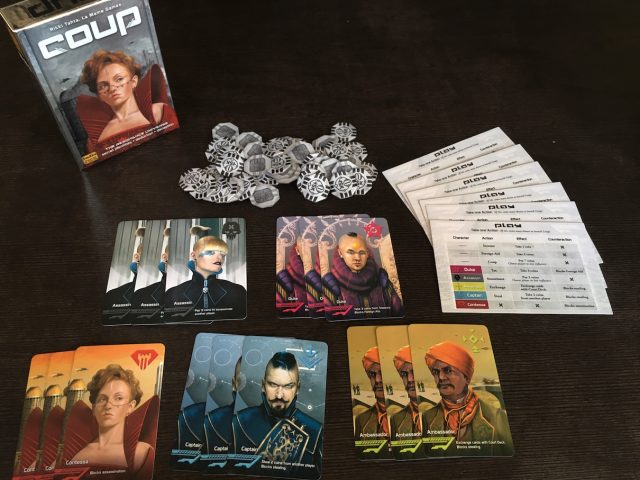
Escape from the Aliens in Outer Space (Ultimate Edition)
2-8 players, 20-45 minutes, age 12+, $35 on Amazon
Escape from the Aliens in Outer Space (EFTAIOS) has been out for years, but last year's "Ultimate Edition" feels like a new (and definitive) take on a tough, tense game of "Predator in a space station." If you like hidden movement and, uh, eating humans—well, this is the game for you. In EFTAIOS, players trapped on an orbiting station become either aliens or humans. The aliens want to find and devour the humans; the humans want to find—and use—the escape pods. The catch is that no one knows anyone else's role or where they are on the station. Each player tracks their own movements in their personal player book, using a dry erase marker and one of the game's numerous included maps. Depending on where they end their moves, players may be forced to reveal their true location—or they may be able to lie about their location or say nothing at all.
The result is a tight, tense hunt in the darkness, working out where other players might be and who they are through deduction. Throw in some item cards and (optional) variable role cards and you have one sweat-inducing game. Though EFTAIOS features possible player elimination, rounds aren't usually long.
Modern classics
Chances are good that one of the below "gateway games" brought you or your giftee into the hobby. If not—if you haven't played these modern classics—what are you doing?! Pick one up and pretend you've been playing it for years.
Dominion
2-4 players, 30 minutes, age 13+, $30 on Amazon
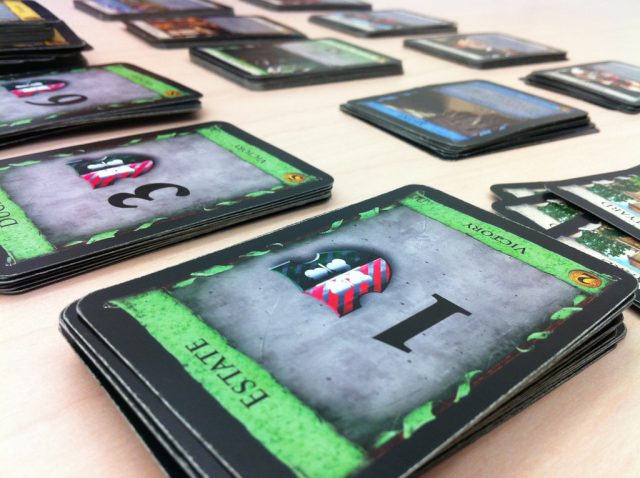
It's kind of like building a Magic: The Gathering deck as you're playing the actual game. Each game, you're presented with a shared market of ten randomly determined decks of "Kingdom" cards, and coming up with a strategy of how best to combo cards from those decks is always a blast. Dominion is ludicrously replayable (when you get bored of the 25 decks included in the base game, there are boxes and boxes and boxes of expansions).
Carcassonne
2-5 players, 30-45 minutes, age 8+, $29 on Amazon
Carcassonne is one of the absolutely foundational games of the modern board gaming hobby and a classic to grace any collection, no matter how casually or seriously you take it. It's an initially pleasant and suddenly absolutely cutthroat game of tile-laying, with players gradually building up a high-medieval map of walled cities, churches, pastures, rivers, and other sundries, and scoring points by placing colored meeples to claim areas from the others. The game was first released in 2000, making it positively venerable in board gaming terms, but unlike many titles from that era or afterward, it still stands up to modern scrutiny. It famously has scores of expansions, becoming something of a fond joke in the gaming community. A few of them are essential and can be acquired with certain versions of the base game. Many others are, shall we say, less necessary. It's also utterly unlike the real Carcassonne, a slightly grimy southern French city also famous for its picturesque castle—a castle that was restored in the 1800s and which in no way resembles any of the authentic structures that previously existed there.
Ticket to Ride: Europe
2-5 players, 30-60 minutes, age 8+, $42 at Amazon
Ticket to Ride is fondly remembered by a considerable number of gamers as their first step into the hobby, a lovely peek at the hinterlands that exist beyond Monopoly. Usually, it must be said, this is because it has Monopoly-esque elements: raw capitalism, competition for areas (in this case rail routes between cities), and lots of plastic pieces you use to block your opponents (train carriages). Players take it in turn to draw cards from a deck containing eight different colors of cards as well as wild cards, and once enough have been collected, can use them to lay trains on routes of the same color between cities, hopefully fulfilling hidden orders that score you points by collecting distant areas to one another. But if someone takes the easy route from A to B before you, it becomes a frenzy of sudden recalculation—if you don't complete all your orders, you lose the points. There are loads of versions, covering the US, India, Germany, the UK and elsewhere in various time periods, but we've chosen Europe as the definitive place to start; it's a slightly larger, more involved map than the US, and the box comes with a few additional elements that make the game deeper. This will be a game that no one will be disappointed to see hit the table, even if people can grow out of it. (It also has a fine app.)
Pandemic
2-4 players, 45 minutes, age 8+, $36 on Amazon

King of Tokyo
2-6 players, 30 minutes, age 8+, $32 on Amazon
It might be by Richard Garfield, the guy who invented Magic: The Gathering, but King of Tokyo, for all its oodles of charm, is at the opposite end of the gaming spectrum in terms of weight and complexity. The format will be instantly familiar to any gamers old enough to remember the old Rampage arcade game that was ported to the NES and the Atari, but it's vibrant enough to appeal to their kids (or grandkids) just as well. Everyone takes on the role of a cartoonish Godzilla-alike and battles for supremacy in Tokyo. This is achieved by chucking pools of dice and using them to score victory points—or hits on your rivals. Tactical complexity comes from power-up abilities you can spend certain dice results on, but in essence, it's all a simple but fierce knockabout battle royale and a perfect gateway drug for a cluster of bored nephews and nieces at a Christmas family gathering. The newest game on this list, we think it has earned its place.
Two-player games
While the majority of modern board games can be played with two players, the best head-to-head experiences are generally those that are designed specifically for a duel. Here are our top picks for this year.
7 Wonders Duel
2 players, 30 minutes, age 10+, $27 on Amazon
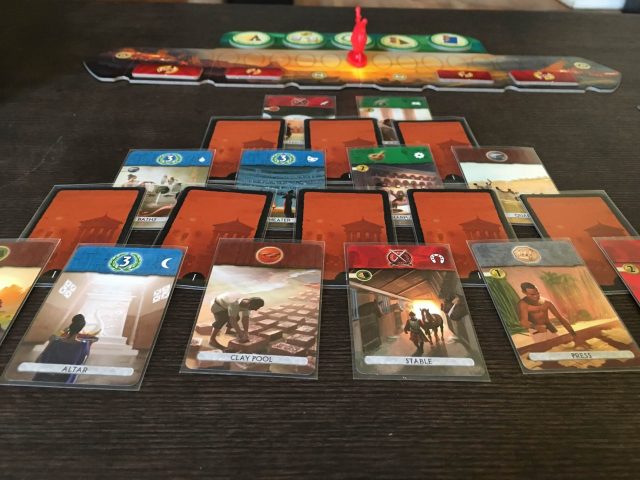
The Fox in the Forest
2 players, 30 minutes, age 10+, $14 on Amazon

As with most trick-takers, one player opens by laying down a single card; the other player has to follow the suit of that card if possible. The highest card played wins that trick. But if it's not possible to follow suit, other suits can be played, and one suit will trump all others, even if not played first. Fox in the Forest tweaks this formula with a series of special cards that let you do things like swap trump suits in the middle of a hand or lose a trick but earn the right to start the next one. In addition, the scoring pushes you to either take no tricks or a lot of tricks if you want maximum points—but don't take too many or you'll end up with nothing.
Jaipur
2 players, 30 minutes, age 12+, $22 on Amazon
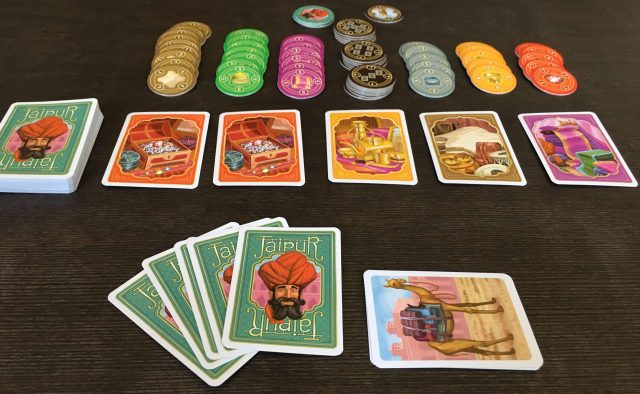
Patchwork
2 players, 15-30 minutes, age 8+, $24 on Amazon
Master board game designer Uwe Rosenberg is best known for his heavy strategy games like Agricola, Caverna, and A Feast For Odin, but his collection also boasts a sizable stable of lighter fare. Patchwork—a game about quilting—is perhaps his best title in this category. You and an opponent fight over Tetris-like "fabric" tiles, which are placed on grids to eventually form quilts. The theme sounds odd—especially when you factor in the currency (cute little blue buttons)—but this game has been a massive hit with everyone we've introduced it to. Patchwork is quick playing, easy to teach, and filled with a surprising amount of tactics and strategy in each session. For a 1-4 player version of the same concept, check out Rosenberg's Cottage Garden.
Schotten Totten
2 players, 20 minutes, age 8+, $13 on Amazon
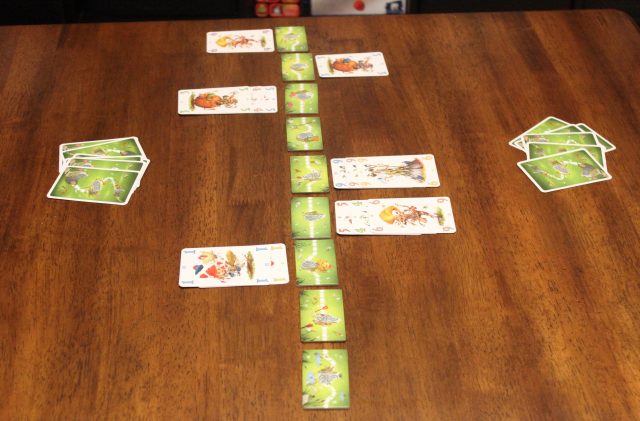
A Reiner Knizia classic, the game is typically light on both rules and theme, but it delivers compelling choices and a great sense of tension as you work to win your stones. Like another Knizia game, Lost Cities, Schotten Totten encourages you to hold cards in your hand for as long as possible, the pressure building until you finally draw the card that will validate your plan to finish a color run on stone seven... or to start a mono-color run on stone eight. Rounds are over in 15 minutes, and this one can be successfully played by smart kids. (Sadly, my daughter regularly beats me.) A set of additional "tactics" cards in the box provides a more advanced variant.
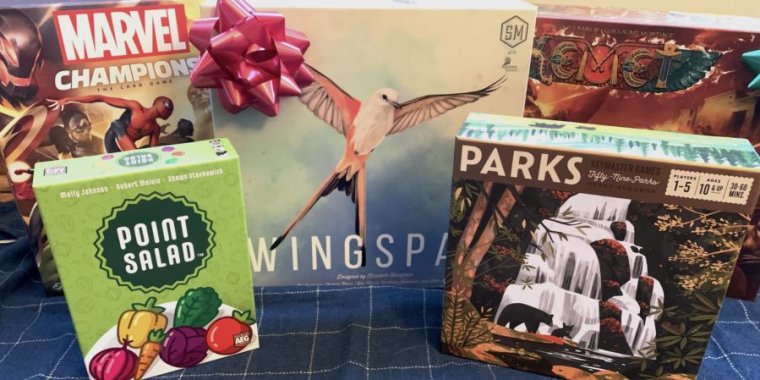
Escape room games
Escape rooms are hotter than ever, migrating from the real world to the tabletop in the last few years. Typically, players work together to escape some form of imprisonment in about an hour, solving clues and codes to find the way to freedom. Here are four of the top series on the market at the moment; to go a little deeper, check out our feature on the genre.
Escape the Room
Stargazer's Manor: 3-8 players, 90 minutes, age 10+, $22 on Amazon
Dr. Gravely: 3-8 players, 90 minutes, age 13+, $20 on Amazon
Some escape room games are simply collections of linked puzzles—just get out of the room, quick!—rather than narrative experiences. But ThinkFun's Escape the Room series layers some nice narrative icing drizzled across its delicious puzzle cake. The series so far consists of two games, Mystery at the Stargazer's Manor and Secret of Dr. Gravely's Retreat. Both feature a colored code wheel for solving puzzles—line up the right colors and symbols to see if you've solved a particular puzzle correctly. Each adventure is set up with a character- and location-driven introduction, and puzzles often advance the plot by providing notes, letters, lab diaries, etc. By the time you're done, you feel like a real adventure has unfolded.
Stargazer's Manor was extremely easy; played in a mixed group of kids and adults, the adults backed off from engaging with the puzzles because they were too often solvable by the kids alone. Because of this, I played Secret of Dr. Gravely's Retreat with my kids rather than with other adults—but the game stepped up the difficulty significantly and would have been terrific with a mixed group. Pick whichever sounds most appropriate for your group, but know that these are not for "hard-core" puzzle-solvers.
Exit: The Game
1-6 players, 60-120 minutes, age 12+, $14 on Amazon
Probably the best of the current "escape room" games, these adventures are just terrifically designed—but they are hard. Don't bust these games out with young children and expect everyone to have a good time. But with a group of committed sleuths, the puzzles on offer here are fresh, going beyond typical code wheels and ciphers and locks. I've played two of these now, and at some point in each game I was blown away by the inventiveness of some game design element. Designed for one-time use, these are still a great value when weighed against the group experience they create. No apps are needed, either.
Exit is one of those games that doesn't break new ground—but it refines existing elements until they shine. The adventures play smoothly, offering challenge without frustration, and they cost only $15 a pop. I'm not alone in this view. The entire series won the 2017 Kennerspiel des Jahres award—a prestigious "game of the year" honor given by German critics to deeper tabletop games.
Unlock!
1-6 players, 45-75 minutes, age 10+, $13 on Amazon
The newest entry in the escape room craze comes courtesy of the biggest board game company in the world, Asmodee, which is known for high production values and strongly thematic designs. Each adventure is literally just a deck of cards; these cards can represent objects, machines, codes, or "other" items (rooms, penalties, or obstacles). Each card is numbered, and new cards are revealed from the deck whenever its numbers appear on some other visible card.
The name of the game here is manipulation. Red and blue object cards can be combined; join the right pair, add up their card numbers, and you can reveal that card number from the deck. Green machine cards can be manipulated through adding various numbers (at which point they often become red cards, which can be joined with other blue cards). Yellow code cards require you to enter a four-digit code into the accompanying digital app. The puzzles feel a bit more mechanical than other escape room games; part of this feel might also be due to the fact that the narrative is essentially nonexistent. Each adventure starts with a paragraph of throwaway text and ends by entering a final door code into the app; there's little attempt to tell a story or set up a compelling situation beyond, "You're locked in a room! Find a way out!" Not our personal favorite, but the series has been popular with gamers.
Stocking stuffers
Little boxes, low prices, big fun.
Qwinto
2-6 players, 20 minutes, age 10+, $14 at Amazon
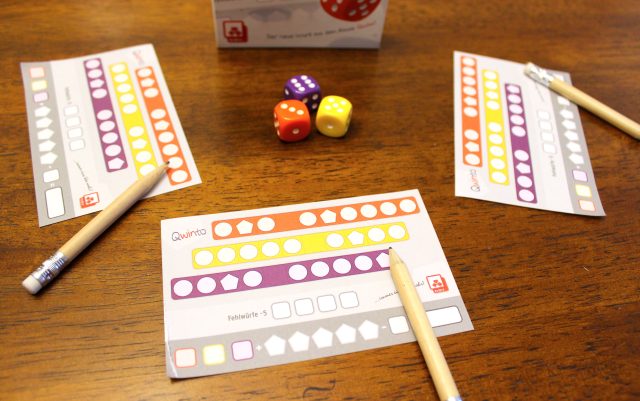
All of these are great, but some are tough to get in English. Fortunately, Qwinto is amazing—rules take two minutes to explain but yield devilishly tough choices throughout—and has just appeared in an English-language version from Pandasaurus. For a quick and accessible roll-and-write that will show your family just how much fun games can be this holiday season, it's hard to beat. Pencils are even included!
Noch Mal
1-6 players, 20 minutes, age 8+, $15 at Amazon
Have we reached "peak roll-and-write" yet? The genre—which combines dice rolling and some kind of markup on physical sheets of paper—has taken over the board gaming world in the last couple of years. Noch Mal (known as Encore in English) is one of the best, though. Created by the dynamic design duo of Inka and Markus Brand, Noch Mal is quick to teach, a blast to play, and colorful as an explosion in a rainbow factory. It's both a puzzle and a race, as all players have to use dice to mark off blocks of colors on score pads—but completing colors and columns first leads to greater rewards. Everyone plays on every turn, so there's no downtime, and the game even comes with tiny markers and adorable wooden dice. (There are also additional scorepads available for purchase if you want different "boards" to play on.) For $15, this is one terrific deal.
No Thanks
3-7 players, 20-30 minutes, age 8+, $10 at Amazon
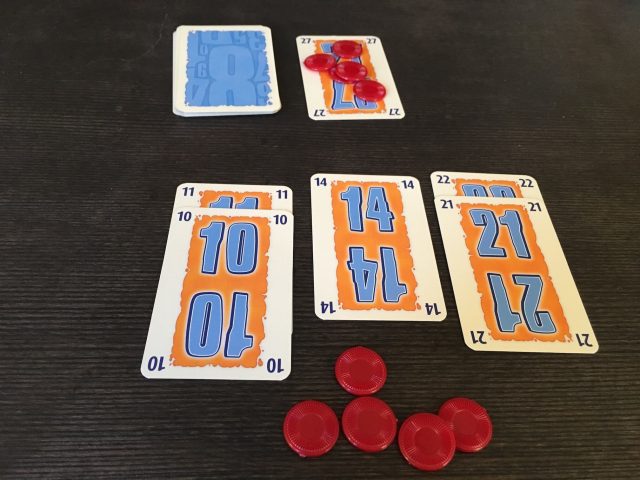
Friday
1 player, 25 minutes, age 13+, $13 on Amazon
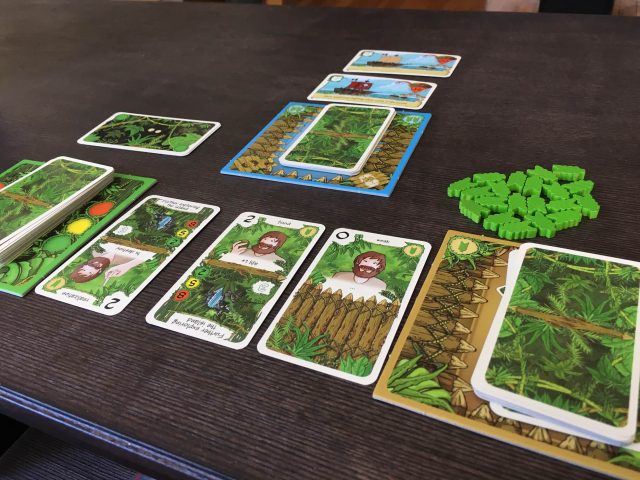
Welcome to the Dungeon
2-4 players, 30 minutes, age 10+, $12 on Amazon
Your group of adventurers stands at the entrance to a dungeon. Within lies great treasure—and many monsters. Unfortunately, only one hero can enter, and your little band is a back-stabbing bunch; to make its decision, the group plays a game of "chicken" in which armor and weapons are continually pared down, even as the dungeon's monster count is amped up. You can always pass, thus removing yourself from the round, and the last player left standing must enter the dungeon and fight all the monsters using whatever weapons and armor remain. The tension comes from pushing your luck, trying to make the dungeon battle so difficult that no other player can survive it—but without being forced to enter the dungeon yourself. With four unique heroes, solid artwork, and a low price, this is a great way to cap a night of gaming.
Star Realms
2 players, 20 minutes, age 12+, $18 on Amazon
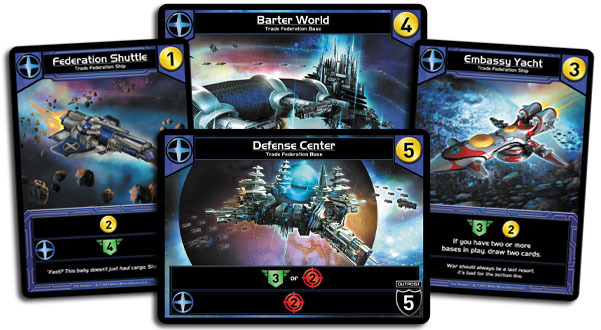
https://news.google.com/__i/rss/rd/articles/CBMiYWh0dHBzOi8vYXJzdGVjaG5pY2EuY29tL2dhbWluZy8yMDE5LzEyL2Fycy10ZWNobmljYXMtdWx0aW1hdGUtYm9hcmQtZ2FtZS1naWZ0LWd1aWRlLTIwMTktZWRpdGlvbi_SAWdodHRwczovL2Fyc3RlY2huaWNhLmNvbS9nYW1pbmcvMjAxOS8xMi9hcnMtdGVjaG5pY2FzLXVsdGltYXRlLWJvYXJkLWdhbWUtZ2lmdC1ndWlkZS0yMDE5LWVkaXRpb24vP2FtcD0x?oc=5
2019-12-14 13:00:00Z
CBMiYWh0dHBzOi8vYXJzdGVjaG5pY2EuY29tL2dhbWluZy8yMDE5LzEyL2Fycy10ZWNobmljYXMtdWx0aW1hdGUtYm9hcmQtZ2FtZS1naWZ0LWd1aWRlLTIwMTktZWRpdGlvbi_SAWdodHRwczovL2Fyc3RlY2huaWNhLmNvbS9nYW1pbmcvMjAxOS8xMi9hcnMtdGVjaG5pY2FzLXVsdGltYXRlLWJvYXJkLWdhbWUtZ2lmdC1ndWlkZS0yMDE5LWVkaXRpb24vP2FtcD0x
Bagikan Berita Ini














0 Response to "Ars Technica’s ultimate board game gift guide, 2019 edition - Ars Technica"
Post a Comment